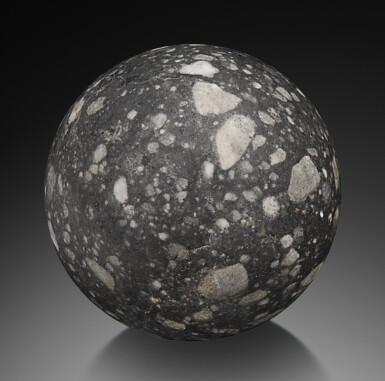Natural History
Natural History

Lunar Meteorite | NWA 12691 — The Moon, Among The Rarest Materials On Earth, Rendered As A Sphere
Lot Closed
December 3, 08:49 PM GMT
Estimate
6,000 - 9,000 USD
Lot Details
Description
NWA 12691 — The Moon, Among The Rarest Materials On Earth, Rendered As A Sphere
Lunar (feldspathic, regolithic breccia)
Sahara Desert, Northwest Africa
30mm (1.2 in.) in diameter and 37.73 grams (188 carats)
Now offered is a lunar meteorite — a specimen from a chunk of the Moon ejected into an Earth crossing orbit following an asteroid impact — fashioned into a sphere.
The Moon is among the rarest objects on Earth — less than 1,200 kilograms is documented. The portion recovered from Apollo Missions (382 kilograms) is untouchable to the public. As for the lunar meteorites, a good deal of that is also untouchable as a result of its residency in the world’s great museums.
This meteorite’s lunar origin was determined by several scientists whose work is vetted by a panel of colleagues prior to publication in the Meteoritical Bulletin, the journal of record. Lunar specimens are identified by specific geological, mineralogical, chemical and radiation signatures. Many of the common minerals found on Earth’s surface are rare on the Moon; in addition, lunar rocks contain gases originating from the solar wind with isotope ratios that are very different than the same gases found on Earth. As would be imagined, some of the lunar samples returned to Earth by the Apollo astronauts closely resemble some lunar meteorites — and this is one such example. The surface of this sample reveals abundant anorthosite inclusions and other clasts of primarily olivine, pigeonite, augite and ilmenite suspended in a melt of dark charcoal-hued lunar regolith (lunar soil). The brecciated structure is the result of the crushing effect of multiple asteroid impacts on the lunar surface before one such impact ejected this material off of the Moon itself into space and then onwards to Earth.
As lunar samples are extremely rare they must be carefully conserved and curated as there is a great deal of material loss in the sphere fabrication process. However, there was recently a discovery in North Africa of a major lunar strewn field which nearly doubled the number of all lunar meteorites known. As a result of the bounty provided by this ancient meteorite shower, an opportunity was provided to create a limited number of lunar spheres from this material. It is anyone’s guess before the recovery of another lunar meteorite event whose total weight is sufficiently high to consider the fabrication of further spheres. In sum, it would prove difficult to find a more enlivening and uncommon extraterrestrial treasure than this presentation of the Moon.
The official classification of this lunar meteorite appears in the 108th edition of the Meteoritical Bulletin. A copy of the publication accompanies this offering.
